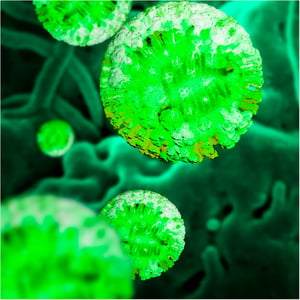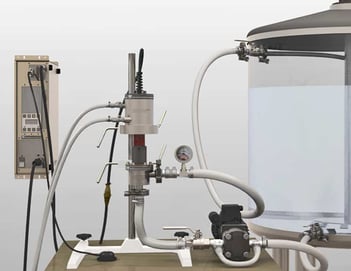 Recent years have seen major breakthroughs in how vaccines and antiviral drugs are formulated and manufactured. Nanoemulsions and liposomes are now widely used as vaccine and drug carriers because they can easily incorporate lipophilic (in the case of nanoemulsions) and hydrophilic (in the case of liposomes) bioactive compounds, stabilize substances that otherwise undergo hydrolysis, and significantly reduce side effects of potent drugs. For the past 14 years, Industrial Sonomechanics (ISM) has been conducting R&D and supplying its scalable ultrasonic technology to many companies in this field, including those using it in ultrasonic vaccine production and, more recently, in the development of SARS-CoV-
Recent years have seen major breakthroughs in how vaccines and antiviral drugs are formulated and manufactured. Nanoemulsions and liposomes are now widely used as vaccine and drug carriers because they can easily incorporate lipophilic (in the case of nanoemulsions) and hydrophilic (in the case of liposomes) bioactive compounds, stabilize substances that otherwise undergo hydrolysis, and significantly reduce side effects of potent drugs. For the past 14 years, Industrial Sonomechanics (ISM) has been conducting R&D and supplying its scalable ultrasonic technology to many companies in this field, including those using it in ultrasonic vaccine production and, more recently, in the development of SARS-CoV-
The industrial manufacture of pharmaceutical-quality nanoemulsions and liposomes (e.g., during vaccine production) requires intense shear forces to be generated in liquids on a large scale. Two techniques are currently capable of achieving the required intensity levels: high-pressure homogenization and high-amplitude ultrasonic processing [1 - 3].

 Prior to the introduction of ISM's scalable Barbell Horn Ultrasonic Technology (BHUT), high-pressure homogenization was applied to the commercial production of vaccines and drug carriers almost exclusively. The only alternative available at the time - conventional high-amplitude ultrasonic processing - was limited to the laboratory scale because the size of the associated equipment cannot be increased without reducing the ultrasonic amplitudes and shear force intensities significantly below the required levels [6]. This lack of options was problematic for the industry since high-pressure homogenization (e.g., microfluidization) suffers from numerous drawbacks, including frequent clogging that leads to the requirement for pre-processing (e.g., with a colloid mill [4]), as well as the use of expensive, large-footprint equipment with high power demand, low efficiency and the need for frequent and costly maintenance [1, 5].
Prior to the introduction of ISM's scalable Barbell Horn Ultrasonic Technology (BHUT), high-pressure homogenization was applied to the commercial production of vaccines and drug carriers almost exclusively. The only alternative available at the time - conventional high-amplitude ultrasonic processing - was limited to the laboratory scale because the size of the associated equipment cannot be increased without reducing the ultrasonic amplitudes and shear force intensities significantly below the required levels [6]. This lack of options was problematic for the industry since high-pressure homogenization (e.g., microfluidization) suffers from numerous drawbacks, including frequent clogging that leads to the requirement for pre-processing (e.g., with a colloid mill [4]), as well as the use of expensive, large-footprint equipment with high power demand, low efficiency and the need for frequent and costly maintenance [1, 5].
The introduction ISM's ultrasonic technology, which, besides being directly scalable, offers precise temperature control, continuous flow-through processing and the ability to operate 24/7, has given the pharmaceutical industry a viable alternative. Barbell Horn®-based ultrasonic processors are free from the above-mentioned drawbacks of high-pressure homogenization and can provide significant productivity and cost advantages. For example, as explained at the end of this review article, our ISP-3000 ultrasonic processor was shown to have an approximately eight-fold greater productivity and a twelve-fold lower power requirement when compared with industrial-scale microfluidization (Microfluidizer M7250) during the production of a common vaccine adjuvant (MF59®) [7, 8].
Since nanoemulsions produced by Barbell Horn-based ultrasonic equipment have extremely small and uniformly distributed droplets, they can be post-processed by sterile filtration, which removes all microorganisms along with any other particulate contamination from the finished products, making it unnecessary to work under aseptic conditions and significantly reducing the associated costs.
 |
Industrial-scale cell disruption (lysing) of microbial cultures is another process demonstrated to be rapid, efficient and simple with Barbell Horn-based ultrasonic processors, especially for the recovery of periplasmic, membrane-bound, or insoluble recombinant proteins [9]. This process is currently used by some of our pharmaceutical industry clients for the production of recombinant vaccines.
Have questions? Contact us or leave a comment below!
References
[1] B. Abismaïl, J.P. Canselier, A.M. Wilhelm, H. Delmas, C. Gourdon, Emulsifica-tion by ultrasound: drop size distribution and stability, Ultrason. Sonochem. 6(1999) 75–83.
[2] Y.F. Ma, C.C. Hsu, Performance of sonication and microfluidization forliquid–liquid emulsification, Pharm. Dev. Technol. 4 (1999) 233–240.
[3] T. Tadros, P. Izquierdo, J. Esquena, C. Solans, Formation and stability of nano-emulsions, Adv. Colloid Interface Sci. 108–109 (2004) 303–318.
[4] S.M. Jafari, Y. He, B. Bhandari, Production of sub-micron emulsions by ultra-sound and microfluidization techniques, J. Food Eng. 82 (2007) 478–488.
[5] S.E. Kentish, T. Wooster, M. Ashokkumar, S.M.R. Balachandran, L. Simons, Theuse of ultrasonics for nano-emulsion preparation, Innov. Food Sci. Emerg. Tech-nol. 9 (2008) 170–175.
[7] Y. Singh, J.G. Meher, K. Raval, M. Chaurasia, M.K. Chourasia, Nanoemulsion: Concepts, development and applications in drug delivery, J. Control Release 252 (2017) 28-49.
[8] A.S. Peshkovsky, S. Bystryak, Continuous-Flow Production of a Pharmaceutical Nanoemulsion by High-Amplitude Ultrasound: Process Scale-up, Chem. Eng. Process.: Process Intens. 82 (2014) 132–136.
.jpg?width=1994&height=332&name=Logo%20Sonomechanics%20White%20No%20Shadow%20R_Final%20(1).jpg)
